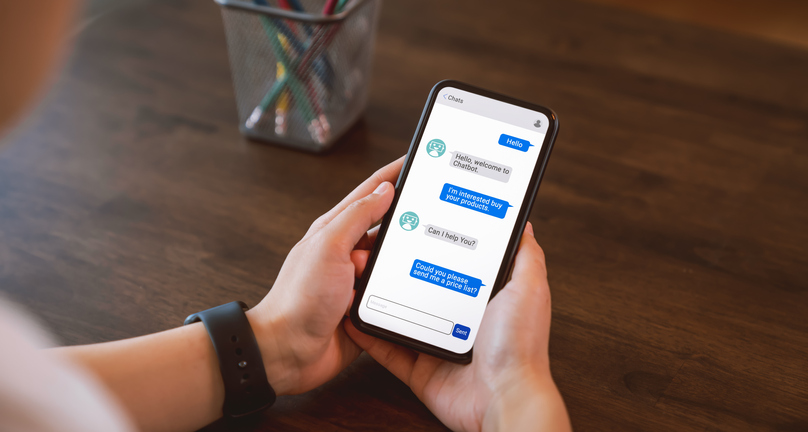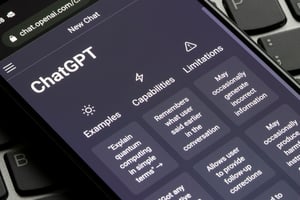- SERVICES
- HIGHER EDUCATION MARKETING
- ENGAGEMENT & ENROLLMENT MANAGEMENT
- STUDENT RECRUITMENT AGENCIES
- PROFESSIONAL EDUCATION & TRAINING
- WHO WE ARE
WHO WE ARE
Learn more about Keystone Education Group, including our leadership structure, why choose Keystone as your educational partner, and company press releases.
QUICK LINKS
- RESOURCES
RESOURCES
Find a range of helpful resources to help with your educational marketing. From on-demand webinars, reports & data, to customer testimonials and our downloadable media kit.
QUICK LINKS
- NEWS
- REQUEST A CALL

- Keystone Higher Education News
- Chatbots: Conversational AI for higher education
In the online world, automation is key to gaining a competitive edge. Chatbots are one such automation tool to provide consumers with a simple solution to answering common questions.
In the higher education field, these nifty tools can be handy for administrators run off their feet with student inquiries. Yet, while chatbots are one way to increase efficiency, there’s perhaps a fine line between automation and providing a human touch.
Chatbot implementation is on the rise
A Helpshift survey of 2,353 consumers across the US, UK, Netherlands, Germany and France found twice as many people surveyed in 2019 would knowingly engage with chatbots because they are “very helpful” compared to 2018 respondents. 83% said they would make messaging their primary means of communication if they were guaranteed to receive an immediate response.
There’s no doubt chatbots are extremely useful for communicating answers to fFAQs. Universities can use chatbots to answer quick questions regarding tuition fees, start dates, application deadlines, and scholarship information. Chatbots can even be tailored to assist with the influx of common questions that arise at specific times of the year, such as at the closing time for applications or at the beginning of each semester.
When it comes to implementing chatbots as a part of your marketing plan, it’s your students who will be the harshest critics if the technology is executed poorly. A study, commissioned by PwC, reveals 60% of consumers will stop using a brand after just a few negative experiences. 59% of customers across the globe feel brands are so married to using automation that they’ve “lost touch” with what makes up a meaningful human experience. If you are wanting to attract international students to your university or college, you must heed this warning and maximise the student experience. One way to do this is to integrate a more personalized approach with your chatbots, or consider other marketing automation options which involve personalized communication.
Creating an emotionally intelligent chatbot
Today’s chatbots do so much more than churn out basic data and facts. Marketers can tailor their chatbots to imitate real human emotions like sympathy, humour, and gratitude. Bots also have the ability to recognise complex human language, and respond accordingly.
Transparency is key
Of course, chatbots aren’t supposed to provide the same level of communication as human service providers, and your students don’t expect to get the same experience when they speak to a bot as they do a human. However, it can be incredibly frustrating for a person to spend time online talking to who they think is a human only to find out they are speaking to a machine. Unhelpful responses from bots are the second biggest annoyance, reported by 35% of consumers in Helpshift’s 2019 report. People are likely to be more forgiving of a bot that isn’t as in-tune with human language as it should be than one that uses human language poorly.
Organizations must value their consumers’ time
Three quarters of adults in the US say the most important thing an organization can do in a customer-service interaction is value their time. University and college marketers should focus on creating the right voice for their bots in every possible context, and then introduce the bots to their students as transparently as possible. If marketers aren’t upfront and transparent with their use of bots, they could risk losing hard-earned student loyalty.
Evolution of chatbots in higher ed
At George Washington University, chatbots are being put to work providing support for IT, administrative and teaching functions. Before the university introduced its chatbot, MARTHA, students would have to call, email, or walk into campus within office hours to get the help they needed. Today, MARTHA fills the gap - helping students with common questions, like, “How do I reset my password?” The chatbot lowers in-person queues and increases student satisfaction with its quick response time.
University of the People (UoPeople) is leading the way in chatbot implementation for education providers. The organization is one of the world’s largest, non-profit, online universities with more than 20,000 students from 200 plus countries. To communicate more effectively with prospective students, UoPeople has a Facebook Messenger bot with Smartloop. The chatbot has the ability to provide interested students with essential information about the university, including the programs it offers and the costs to attend. The chatbot is even able to determine whether the person meets the requirements to attend the university and, if so, invite the student to apply. This takes lead generation to the next level, reaching students right where they’re at - on social media - and stepping them through a marketing funnel.
As a higher education marketer or administrator, you can learn a lot from these providers and should take into careful consideration how chatbots can be used in new and exciting ways to attract international students. While the efficiency benefits of chatbots are undeniable, it is important to remember that prospective students desire personalisation and will require human contact from time to time for more complex problems.
Automation tools, like chatbots, should be used to their full advantage but, most importantly, marketers need to strike the right balance between intelligent automation and human interaction for success.
More about:
Related Tags
Just For You
Top Picks
Higher Ed Chats Podcast
Listen to the latest episodes of our Higher Ed Chats Podcast - new format for 2024. Hear from Higher Ed thought-leaders from around the world!
Who Will Win The Keystone Awards?

Watch the Keystone Awards Ceremony to see the winners of the 2025 Keystone Awards!
Subscribe
to get the latest news and updates





